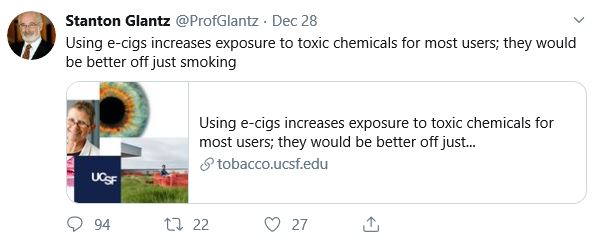Stanton Glantz finally reveals his real agenda
Former aeronautical engineer and long-time anti-vaping activist Stanton Glantz has made a string of increasingly extreme denunciations of harm reduction in recent years, but this week he at last openly said what he’s been hinting at all along – he wants smokers to keep smoking.
In an astonishing rant on the blog he’s allowed to host by his workplace, the University of California in San Francisco, Glantz claimed that because dual users of e-cigarettes and tobacco are exposed to toxicants from both, they would be better off if they just smoked. This totally ignores the conclusions of Glantz’s own latest research, which found – as expected – that vaping exposes users to a tiny fraction of the toxicants found in cigarette smoke.
Somehow, what Glantz has concluded from this research is that people who use two nicotine products should quit the safer one and keep using the one that is two orders of magnitude more harmful. Even by the standards of the tobacco control industry this degree of bias is appalling.
Suggesting that smokers should continue to smoke, rather than switch to an alternative that eliminates almost all the risk, should destroy any remaining credibility Glantz has as an anti-smoking activist. Unfortunately it’s more likely he’ll continue to be paraded as an expert by the media, despite his opposition to harm reduction being out in the open at last.
PHE pushes pro-vaping message
Public Health England, the UK government agency responsible for most of the country’s health policy, has launched a campaign to educate the public about the relative safety of smoking and vaping. The move follows growing concern about the effects of misinformation by anti-harm reduction activists like Martin McKee and Robin Ireland, which have seen the number of people who know vaping is a safer option actually falling.
The centrepiece of the campaign is a video comparing the effect of a year’s worth of e-cigarette vapour on a jar full of cotton wool balls with the effect of a year’s worth of cigarette smoke. The experiment, conducted by tobacco expert Dr Lion Shahab, dramatically illustrates how much less harmful vapour is.
PHE’s tobacco programme leader, Martin Dockrell, emphasised that most of the so-called risks of vaping are derived from studies that don’t make any comparisons with smoking. As almost all vapers are current or former smokers – despite what alarmists claim – this is an important factor. For most users the choice isn’t vapour or fresh air – it’s vapour or toxic, carcinogenic smoke.
FDA wants to meet vape companies
The commissioner of the Food and Drug Administration, Scott Gottlieb, said on Thursday that his agency is planning a series of meetings with vapour product manufacturers. This is the latest move in the FDA’s war against harm reduction, which it’s justifying with claims of an “epidemic” of vaping among young people.
The reality is that most teens who vape regularly were already smokers, and will benefit from using a reduced-harm alternative. The increased numbers of “current users” that show up in flawed studies are mostly teens who’ve had one or two puffs in the last month – usually just to see what all the fuss in the media is about – but aren’t, in any meaningful sense, vapers.
Now the FDA wants to meet vape industry executives to discuss the commitments they’ve already made and, no doubt, try to extort more confessions from them. Unfortunately the FDA, like the CDC and Surgeon General, remain obsessed with the fact e-cigs come in “child-friendly” flavours, like cucumber, and may be shaped vaguely like USB sticks – this fact is incredibly important to them, for some reason.
More states push anti-vaping laws
The US Surgeon General’s recent announcement of a “vaping epidemic” seems to have emboldened lawmakers across the USA. In the last week, laws targeted on reduced harm products have been proposed in New York, Connecticut, Utah and several other states. Proposed measures include bans on the sale of vapour products except in stores where only adults have access, increased fines for retailers who sell to teens, more flavour bans and higher taxes – Utah wants to tax cigarettes and vapour products at the same rate. Unfortunately, with most of the US health establishment still taking a prohibitionist line on reduced-harm products, it looks like things will keep getting worse for US vapers.








